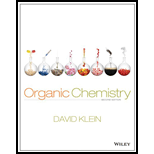
(a)
Interpretation: For the given set of compounds, the compound with higher boiling point has to be identified.
Concept Introduction: The boiling points for the given set of compounds will be identified by knowing dipole-dipole interactions, hydrogen bonding, number of carbon atoms and extent of branching within the given set of compounds.
A dipole-dipole interaction is the attraction between two polar molecules. When they approach each other, the negative end one molecule attracts the positive end of the other.
The interaction between highly electronegative atom and hydrogen atom is called hydrogen bonding. Electronegative atom should have lone pair of electrons to form hydrogen bonding. It is the process of interaction only i.e., no bond formation is involved.
Boiling points can be distinguished by the molecular weight of the compounds. It is based on the number of heavier atoms involved in bond formation. Linear or branching manner can also involve in the determination of boiling points. The compound with less branching structure has more boiling points and vice versa.
To find: The higher boiling point of a compound in the given pair of the compounds (a)
(b)
Interpretation: For the given set of compounds, the compound with higher boiling point has to be identified.
Concept Introduction: The boiling points for the given set of compounds will be identified by knowing dipole-dipole interactions, hydrogen bonding, number of carbon atoms and extent of branching within the given set of compounds.
A dipole-dipole interaction is the attraction between two polar molecules. When they approach each other, the negative end one molecule attracts the positive end of the other.
The interaction between highly electronegative atom and hydrogen atom is called hydrogen bonding. Electronegative atom should have lone pair of electrons to form hydrogen bonding. It is the process of interaction only i.e., no bond formation is involved.
Boiling points can be distinguished by the molecular weight of the compounds. It is based on the number of heavier atoms involved in bond formation. Linear or branching manner can also involve in the determination of boiling points. The compound with less branching structure has more boiling points and vice versa.
To find: The higher boiling point of a compound in the given pair of the compounds (b)
(c)
Interpretation: For the given set of compounds, the compound with higher boiling point has to be identified.
Concept Introduction: The boiling points for the given set of compounds will be identified by knowing dipole-dipole interactions, hydrogen bonding, number of carbon atoms and extent of branching within the given set of compounds.
A dipole-dipole interaction is the attraction between two polar molecules. When they approach each other, the negative end one molecule attracts the positive end of the other.
The interaction between highly electronegative atom and hydrogen atom is called hydrogen bonding. Electronegative atom should have lone pair of electrons to form hydrogen bonding. It is the process of interaction only i.e., no bond formation is involved.
Boiling points can be distinguished by the molecular weight of the compounds. It is based on the number of heavier atoms involved in bond formation. Linear or branching manner can also involve in the determination of boiling points. The compound with less branching structure has more boiling points and vice versa.
To find: The higher boiling point of a compound in the given pair of the compounds (c)
(d)
Interpretation: For the given set of compounds, the compound with higher boiling point has to be identified.
Concept Introduction: The boiling points for the given set of compounds will be identified by knowing dipole-dipole interactions, hydrogen bonding, and number of carbon atoms and extent of branching within the given set of compounds.
A dipole-dipole interaction is the attraction between two polar molecules. When they approach each other, the negative end one molecule attracts the positive end of the other.
The interaction between highly electronegative atom and hydrogen atom is called hydrogen bonding. Electronegative atom should have lone pair of electrons to form hydrogen bonding. It is the process of interaction only i.e., no bond formation is involved.
Boiling points can be distinguished by the molecular weight of the compounds. It is based on the number of heavier atoms involved in bond formation. Linear or branching manner can also involve in the determination of boiling points. The compound with less branching structure has more boiling points and vice versa.
To find: The higher boiling point of a compound in the given pair of the compounds (d)
Want to see the full answer?
Check out a sample textbook solution
Chapter 1 Solutions
Organic Chemistry
 ChemistryChemistryISBN:9781305957404Author:Steven S. Zumdahl, Susan A. Zumdahl, Donald J. DeCostePublisher:Cengage Learning
ChemistryChemistryISBN:9781305957404Author:Steven S. Zumdahl, Susan A. Zumdahl, Donald J. DeCostePublisher:Cengage Learning ChemistryChemistryISBN:9781259911156Author:Raymond Chang Dr., Jason Overby ProfessorPublisher:McGraw-Hill Education
ChemistryChemistryISBN:9781259911156Author:Raymond Chang Dr., Jason Overby ProfessorPublisher:McGraw-Hill Education Principles of Instrumental AnalysisChemistryISBN:9781305577213Author:Douglas A. Skoog, F. James Holler, Stanley R. CrouchPublisher:Cengage Learning
Principles of Instrumental AnalysisChemistryISBN:9781305577213Author:Douglas A. Skoog, F. James Holler, Stanley R. CrouchPublisher:Cengage Learning Organic ChemistryChemistryISBN:9780078021558Author:Janice Gorzynski Smith Dr.Publisher:McGraw-Hill Education
Organic ChemistryChemistryISBN:9780078021558Author:Janice Gorzynski Smith Dr.Publisher:McGraw-Hill Education Chemistry: Principles and ReactionsChemistryISBN:9781305079373Author:William L. Masterton, Cecile N. HurleyPublisher:Cengage Learning
Chemistry: Principles and ReactionsChemistryISBN:9781305079373Author:William L. Masterton, Cecile N. HurleyPublisher:Cengage Learning Elementary Principles of Chemical Processes, Bind...ChemistryISBN:9781118431221Author:Richard M. Felder, Ronald W. Rousseau, Lisa G. BullardPublisher:WILEY
Elementary Principles of Chemical Processes, Bind...ChemistryISBN:9781118431221Author:Richard M. Felder, Ronald W. Rousseau, Lisa G. BullardPublisher:WILEY





